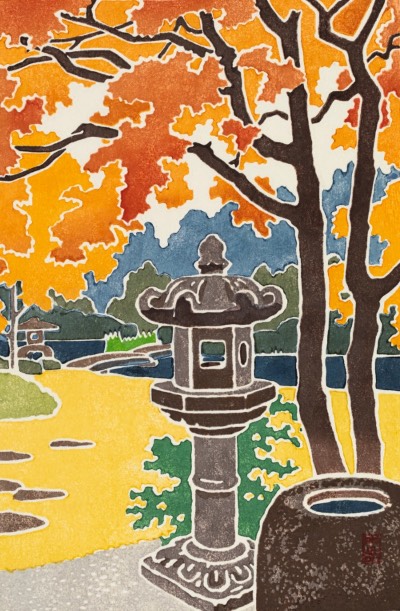Toshi Yoshida
(Japanese, 1911–1995)
Two Lanterns (Futatsu no ishidoro), 1964
Polychrome woodblock print
Museum purchase with funds donated by Susan M. Reifer ’65 and Stanley J. Reifer ’64
(2025.24.3)
This Japanese garden scene depicts two stone lanterns and a water basin in a rich autumn landscape. A large pedestal-style lantern occupies the center of the composition. It stands on a textured pathway adjacent to a barrel-shaped stone water basin. Such lanterns are staple features in Japanese gardens, where they provide illumination, often at a turn in a path, on the edge of water, adjacent to a basin, or near a bridge. The blue ellipse of water in the basin nods toward its purpose as a hand-washing station. This lantern, basin, and path might hint at a tea room just outside the bounds of the frame. The lantern is flanked by a tree whose red and orange branches arch over it, encircling the scene and providing balance to the lantern’s height.
A scattering of stones on a yellow lawn leads one back to the water’s edge, where a second lantern stands on a bank. This type of shorter lantern on long, arching legs is usually placed on the edge of water. It is positioned here next to a foot bridge, leading one over the water and farther back into the garden.
This print is from the artist’s "white-line" garden series, which uses a white outline rather than a traditional black one to define the shapes. The artist used a blind-printed or embossed technique for the white outline, which adds a crisp vibrancy to the colors and highlights the paper’s texture. He also cut the blocks for this print himself, a task artists often delegated, but which provides greater control over the final product. The artist’s seal in red is stamped in the lower right, with his name and the print’s title below. The title and date are also embossed in the left margin.
Toshi Yoshida was a member of the prominent Yoshida family, a multi-generational family of talented artists who worked across a range of media and styles. His father, Hiroshi Yoshida, trained as an oil painter before transitioning to print-making in the 1920s. He established the Yoshida Studio in Tokyo in 1925. Toshi Yoshida began painting and printmaking at an early age, studying under both of his parents. Throughout his life, he produced a wide range of works and art forms, inspired by his global travels and diverse influences, and became one of the most successful Japanese woodblock artists of the 20th century.
Search the database
To find objects in our permanent collection, search our database here.
